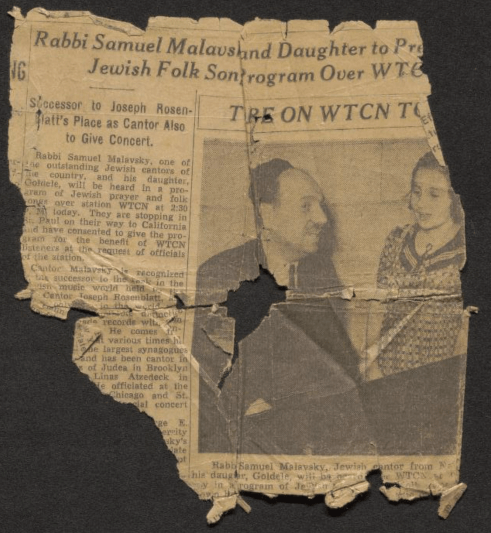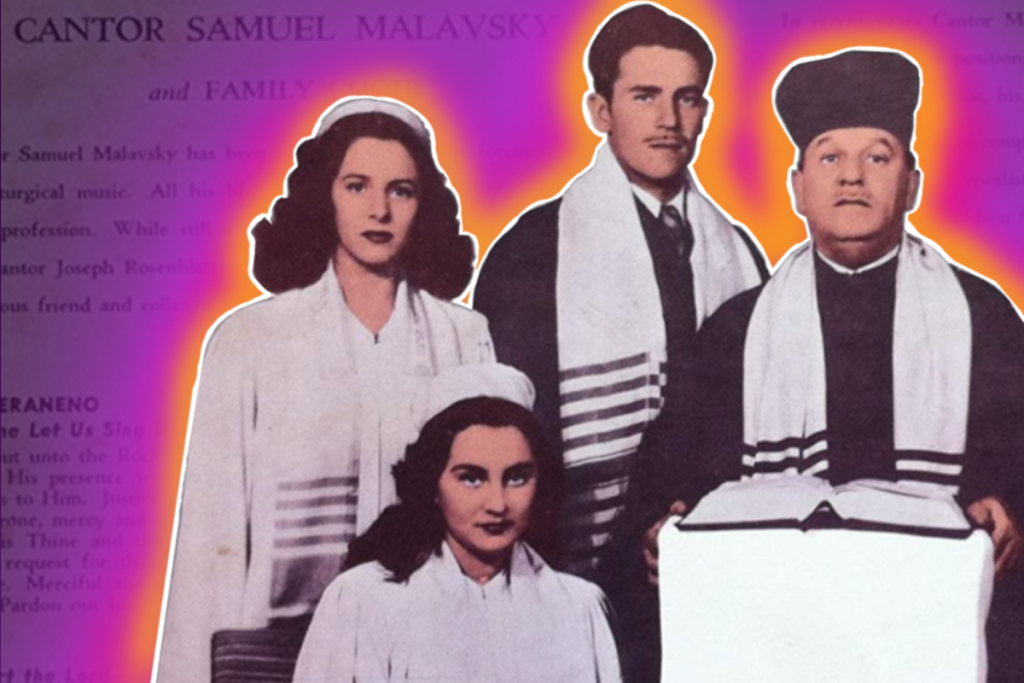The Malavsky girls and the gender “riot”
by Jeremiah Lockwood, Research Fellow
Lowell Milken Center for Music of American Jewish Experience
A hair-raising gender riot in a synagogue in Brooklyn helped drive the Malavsky’s out of the pulpit and onto the borscht belt circuit, creating new opportunities for female leadership in prayer and new settings for ritual in the late 1940s.
The Malavsky Family Choir was a key proponent of a mid-20th century American Jewish aesthetic defined both by a retrospective sentimental focus on European heritage music, especially khazones (cantorial music), and by a fluency in the sounds and production styles of contemporary commercial music for radio and film. The father and choir leader, Samuel Malavsky (1894-1983) was born in Russia, where he toured as a boy soloist in cantorial choirs. After immigrating to the United States in 1914, Samuel was taken under the wing of Yossele Rosenblatt, the vastly popular cantor and star of vaudeville and cinema. [1] Rosenblatt’s tutelage helped Malavsky develop a star reputation, evolving into a major record contract and excellent pulpit positions. His children, in addition to singing in their father’s cantorial choir, sang pop music and light jazz. Two of his daughters, Trudie and Goldie, had a duo vocal band working under the name the Marlin Sisters. The Marlin Sisters made some minor hit novelty records, including “Toolie Oolie Doolie” in 1948 under yet another pseudonym, The Polka Debs. Their recording of “Toolie Oolie Doolie” peaked at the #61 position on the pop charts and was covered by the Andrew Sisters. [2] While it would be convenient to draw a line of demarcation between the father and his daughters, with the former representing the “Old World” and Jewish musical tradition and the latter flowing into the sea of assimilation and pop culture, the music of the Malavskys paints a more complex picture. The work of Goldie Malavsky (1923-1995), the eldest daughter and one of the most significant cantorial performers of the post-Holocaust period, points to the persistence of traditionalism across generations, across the divide of immigrant and native-born American, and against the grain of normative gender roles in cantorial music that forbid women from the pulpit. Furthermore, her comfort in code switching between American and Jewish musical sounds and contexts intimates the emergence of an exuberantly confident Jewish multi-culturalism. As the anecdotes I highlight in this essay suggest, mid-century Jewish religious institutions were not prepared to embrace the Malavskys’ fluid approach to gender, heritage and cultural hybridity in the synagogue.
Among the online resources relating to the Malavsky’s in the collection of the Milken Center is an interview that will soon be made available on its website. The video features three of the Malavsky daughters, Trudie, Minnie and Ruth, being interviewed by cantorial record producer and promoter Barry Serota on February 26, 1998. The sisters speak reverentially about their father and their deceased elder sister, stressing their achievements and the joy of making music together as a family. In a distinctly less hagiographic mode, the sisters talk about the gender violence they encountered, both as women in America and specifically as Jewish women whose work made them visible and vulnerable to criticism in the community.
In one anecdote early on in the interview, Ruth tells a story about her elder sisters Trudie and Goldie that had apparently become part of family lore. Samuel was traveling by train across country by train with his elder daughters when the car filled up with soldiers just returned from the Second World War who began paying aggressive unwanted attention to the young women. The father was terrified that the soldiers “making eyes” at his daughters could take a more sinister turn. To assuage the undisciplined and threatening libidos of the soldiers, Cantor Malavsky instructed his daughters to sing Christmas carols. Through the soothing sound of familiar religious melodies being sung, the danger was neutralized, and the soldiers fell asleep. At the next stop, Samuel took his daughters off the train “in the middle of nowhere” late at night, seeking safety. In this story, the girls’ ability to code switch into an American expressive style enabled them to diffuse the sexual danger of their situation. By translating their identities as Jewish sacred singers into an American Protestant idiom, the Malavsky sisters drew on their intimacy with religious rites and feelings to navigate the out-of-control aggression of soldiers staggering out of a period of sustained violence.
Travel, with its incumbent discomforts and dangers, had been a persistent theme in Samuel Malavsky’s life since he was a small child. In the interview, Ruth highlights his childhood loneliness and the challenge of being isolated from his family while on tour in Russia. As a star cantor in America, Malavsky had trouble settling down and toured frequently, both with his mentor Rosenblatt and by himself. He seemed to have continued to associate khazones with an itinerant lifestyle into later adulthood. Even after marrying and having children, he moved the family repeatedly. Almost all six of his children were born in different cities. When his children grew to early adulthood and started showing signs of musical talent, he decided to form a family choir. Goldie was his special protégé. According to her sisters, Goldie began singing on a weekly radio broadcast at the age of 6, apparently singing cantorial pieces. Samuel seems to have been grooming her as the recipient of his cantorial knowledge from almost the beginning of her life. Her sisters gushed about her, “She had the most wonderful alto voice…She sang just like a boy.” Goldie’s charisma, it seems, sprang in part from the gender ambiguity in her singing. Her voice was heard as female, but the musical repertoire she sang, with its idiomatic muscular coloratura and extra-musical noises, such as the characteristic krekhts, or crying sound, were popularly understood as signifiers of male cantorial professional knowledge. Her position as a female cantorial prodigy was made possible by the new media of the radio, a format in which women’s performance was unmarked and normal. In the new Jewish mediascape of radio, phonograph and Yiddish theater, women singers, often referred to as khazentes, had been performing cantorial repertoires in the United States since the early part of the century. [3] Goldie took the khazente phenomenon a step further, extending her musical expertise into the ritual space of the synagogue.

Malavsky had a prestigious post in a synagogue in San Francisco which he left with the intention of moving back to New York. He believed New York, with its multiple major synagogues that employed choir directors as well as cantors, would offer more support to his new family cantorial choir. Malavsky seems to have ignored the revolutionary potential of a mixed gender choir in the Orthodox milieu in which he was usually employed. Perhaps he was aware of the precedent of mixed choirs in urban liberal synagogues in Europe, especially in elite Central European capitals such as Berlin and Budapest. [4] Even in the Russian territories, there were examples of women singers in synagogue choirs. The Broder Shul in Odessa featured women choir members during the tenure of the famed Cantor Pinchas Minkovsky. Although Broder was nominally an Orthodox synagogue, the demands of the prestigious cantor and choir director seem to have prevailed against traditional prescriptions against women’s voices. [5] Uprooting the family from California to the East Coast, the Malavskys planned a debut at a large synagogue on Eastern Parkway in Brooklyn. The Malavsky sisters, somewhat tentative in their recollection, place this event at the Crown Heights Jewish Center, a major Conservative synagogue.
At their Brooklyn debut Sabbath service in 1948, a riot broke out. Young Chassidic men entered the sanctuary throwing stink bombs directly at the pulpit. “Imagine. By the Torah. On the pulpit…They did such a terrible thing,” Minnie recalled, the indignation still rising in her voice fifty years later. Some of the “yeshivah bokhers” (religious school students) directly confronted the girls, menacing them and intimating that “they wanted to tear their clothes.” Their mother intervened. Minnie imitated her mother’s gesture of an outstretched arm thrust between her daughters and their attackers. “Leave them alone. Leave them alone.” She rushed the girls out of the synagogue to safety. The story mirrors anecdotes about pogroms, with their recurring themes of violence in synagogues and young women being violated. But in this story of hate, the vector of enmity does not include non-Jews, but rather was directed at Jewish females by Jewish males. The synagogue, even a prestigious and elite institution like the Crown Heights Jewish Center, could not provide protection against the powerful antagonism against women’s voices. Beyond this one particularly harrowing incident of gender violence, the Malavskys faced sustained opposition from the kinds of Orthodox and Conservative synagogues where their style of prayer leading would have fit local ritual customs.
Ruthie explained flatly, “We got out of the shuls. We went to the Hotels. We went to the Concord. We went to Grossinger’s.” Facing a hostile situation in the synagogue, Samuel Malavsky looked for opportunity elsewhere; he was not dissuaded from his plan of singing with his children and featuring Goldie’s interpretations of khazones in the family choir. Instead, the family began to produce services at Jewish resorts and in theaters, in addition to offering concerts, radio programs and recording prolifically. They toured constantly. Ruth commented on the sacrifices their father made in his career in order to be able to maintain the Family Choir: “People used to say Papa used us. But I think Papa gave up an awful lot just to sing with his children…He could have been better off in his career without us.” Casting aside the safety of a prestigious pulpit position, Malavsky embraced the model of the traveling cantor and choir he had grown up with in Russia. Trudie recalled touring and drives that would sometimes extend from Florida to Winnipeg in the space of a single epic day. In their pursuit of a space in which they could offer their own sacred musical concept that pushed at the rules of gender, the Malavskys were literally driven to the ends of their world.
NOTES
1. “Samuel Malavsky,” Jewish Virtual Library. (https://www.jewishvirtuallibrary.org/malavsky-samuel).
2. “Billboard Magazine’s Top Singles of 1948,” (http://hitsofalldecades.com/chart_hits/index2.php?option=com_content&do_pdf=1&id=701).
3. Arianne Brown, “The Khazntes—The Life Story of Sophie Kurtzer, Bas Sheva, Sheindele the Khaznte, Perele Feig, Goldie Malavsky and Frayedele Oysher” Journal of Synagogue Music 32, 2007; Henry Sapoznik, “The Promiscuous World of Jewish Music Series, Lecture 18: Kol Isha: The Pioneering Women Cantors 1923-1975,” Public lecture on Zoom, September 14, 2020
4. For an example of a mixed choir piece of Jewish liturgy see Jakob Dymont, Rinat Yaakov: freitagabendliturgie für Kantor und gemischten Chor mit Orgelbegleitung, Berlin: c. 1895.
5. V. Levin, “Reform or Consensus? Choral Synagogues in the Russian Empire.” Arts 9 no. 72, 2020, 28.


